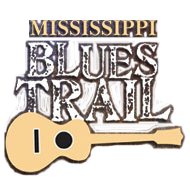Bud Scott
Bud Scott - Natchez
Clarence “Bud” Scott, Sr., led one of the most popular dance bands in the Mississippi-Louisiana region for several decades beginning around 1900. Scott (1876-1938), a lifelong Natchez resident, was renowned among both white and black audiences. Although the dances were segregated, the entire community could hear Scott when he sang from the balcony of the Natchez Confectionery at this site. Scott’s son, Clarence, Jr., (1908-1940), also known as Bud, led the band in its later years.
Bud Scott was the most famous African American musician in Mississippi during the early decades of the twentieth century. Across the state and in Louisiana, newspapers that rarely covered African Americans advertised and reported his appearances in glowing terms; some ads promoted his band as “the best orchestra in the South—bar none.” The 1938 Federal Writers’ Project called him “Mississippi’s own pioneer in jazz” and named him among the six most nationally prominent Mississippi-born musicians. He achieved such stature strictly through his legendary live performances—he apparently never made a record or published his songs. Scott was in demand for the busy Natchez schedule of society affairs at mansions, hotels, clubs, and halls, as well as on riverboats. He played for three U.S. presidents and entertained throughout the region at pageants, military balls, political rallies, conventions, graduations, rodeos, town pavilions, ballrooms, theaters, and fairs. A New Orleans reporter later reminisced, “In Mississippi, a Bud Scott dance was to die for.” Serenading was another Natchez tradition championed by Scott’s band and others who played on the steps of antebellum homes and also strolled the black neighborhoods.
Scott, born on October 25, 1876, was also known as “Professor,” a title accorded respected orchestra leaders of the era. Best known for his singing, he was also a composer who played mandolin and other instruments. His band, which often carried twelve to fifteen pieces, used various names, including the Syncopators and, on one 1902 theatrical bill, Bud Scott and his Senegambian Assistants. The group kept pace with the times, evolving from a ragtime string band into a hot jazz outfit and then a swing orchestra with a horn section. Such bands’ repertoires commonly included blues, rendered as both vocals and instrumentals, and Scott’s versatility extended from ballads to cakewalks to the latest Broadway hits. His music made headlines in 1919 when his sizzling rendition of “Eliza Jane” (“L’il Liza Jane”) turned a sedate Meridian affair into a near-riot as dancers broke rank with the old waltzes and square dances to do the shimmy, hesitation, and tickle toe.
Several band members, including Scott’s son Clarence Jr., son-in-law Walter King, Jim Ferguson, and Alonzo Skillens, lived at or next to Scott’s house on Union Street. Pianist Tom Griffin was among the bandsmen who went on to lead their own groups or perform as featured acts. Other bands active in Natchez by the 1930s included Monk Hoggatt and his Revelers and the Otis Smith Orchestra. Scott, who died on November 23, 1938, was in poor health in his final years and unable to sing, but Bud Scott, Jr., and the band continued to perform. Scott, Jr., was preparing for an upcoming show with the band in Greenville when he perished in the famous Rhythm Club fire of April 23, 1940. Arthur “Bud” Scott (1890-1949), a renowned New Orleans jazz musician, was not related, but biographies of the various Bud Scotts have often been confused.
content © Mississippi Blues Commission
[ BACK TO TOP ]

